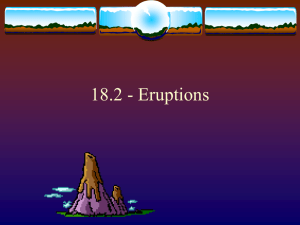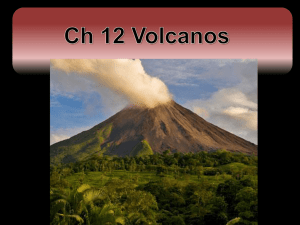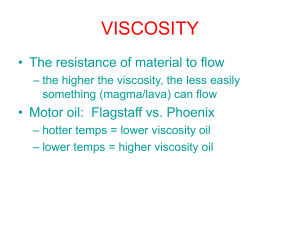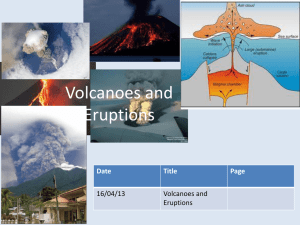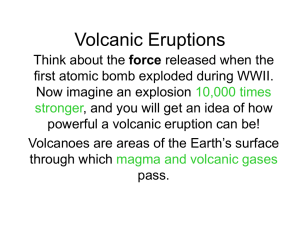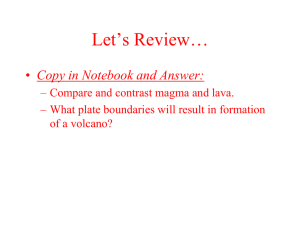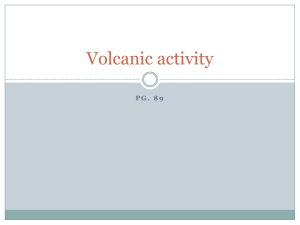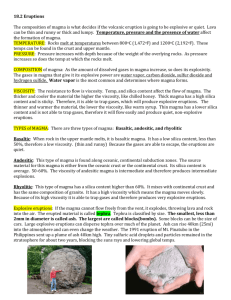Types of Volcanoes
advertisement
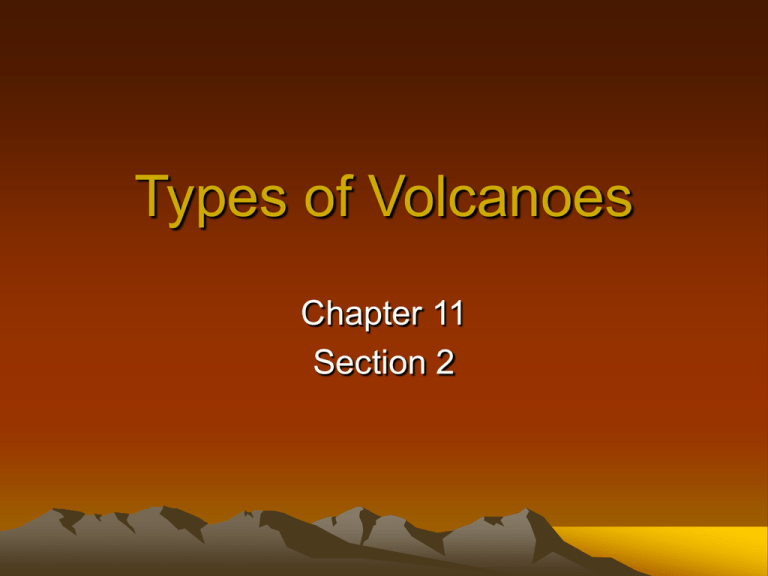
Types of Volcanoes Chapter 11 Section 2 Types of Eruptions: • Quiet • Explosive • Determined by: – Amount of water vapor/trapped gases in the magma. – Amount of silica (silicon and oxygen) in the magma. Quiet Eruptions • Contain basaltic magmas – Low in silica – Flows very easily • Contain gases that are easily released due to the high viscosity (ability to flow) of the magma. Quiet Eruptions • Pahoehoe – Lava cooled in a rope-like structure • Aa – Forms at lower temperatures than pahoehoe • Pillow lava – Igneous rock structures shaped like baloons, tubes, or pillows. Quiet Eruptions • Examples: – Hawaii – Rift zones (Iceland) Explosive Eruptions • Contain granitic magma – High in silica – Thick – Low in viscosity (ability to flow) – Contains many trapped gases • May also contain andesitic magma – Intermediate silica content Explosive Eruptions • Examples – Convergent boundaries Forms of Volcanoes • Dependent upon type of magma and type of eruption. • 3 basic forms: – Shield volcanoes – Cinder cone volcanoes – Composite volcanoes Shield Volcano • Broad volcano with gently sloping sides. • Result of basaltic magma and quiet eruptions. • Example: Hawaii Flood Basalts • Occur when basaltic magma flows onto the surface of the earth through large cracks called fissures. – When the magma cools, it covers large areas with thick igneous rock. – Accounts for largest volume of erupted volcainc material on Earth. • Examples: – Columbia Plateau – New ocean floor Cinder Cone Volcano • Form when tephra fall to the ground and form a loosely-packed steep-sided structure. – Tephra consist of bits of rock or solidified lava drpped from the air. • Includes volcanic ash, cinders, and larger rocks called bombs and blocks • Example: – Paricutin – Feb 20th, 1943 Types of Tephra • Volcanic Ash – Tephra particles less than 2 mm in diameter. • Volcanic Dust – Particles less than 0.25 mm in diameter. • Lapilli – Larger tephra particles, less than 64 mm in diameter. • Generally fall near the vent. Types of Tephra • Volcanic Bombs – Tephra particles with round or spindle shape. • Volcanic Blocks – Solid rocks blasted from a fissure. Composite Volcano • Formed from alternating quiet and explosive eruptions, depending on the amount of trapped gases and silica content at the time of eruption. • Result is alternating layers of tephra and lava. • Examples: – Convergent boundaries – Mount St. Helen’s, Mount Raineer Krakatau • Island in the Sunda Straits near Indonesia. • Erupted in August of 1883, causing the “island” to collapse into the empty magma chamber (caldera-forming). • More than 36,000 people were killed (mainly by a tsunami) • Global temps dropped as much as 1.8 degrees Celsius for five years. Effects of Eruptions • • • • • Lava flows Collapse of buildings from ash fall Air pollution (lung disease/stress) Acid rain Pyroclastic flows – Huge, hot, fast rush of ash and debris down the mountain (can result in fires) • Permanent/Temporary Evacuation

